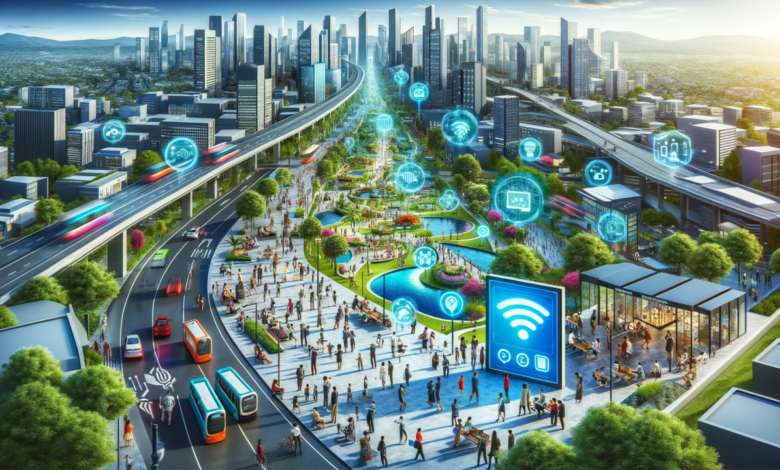How Smart Cities Connect: Bridging Technology and Urban Living

How Smart Cities Connect: Bridging Technology and Urban Living
In today’s rapidly evolving world, “smart cities connect” has become a vital solution to urbanization, population growth, and environmental sustainability challenges. As cities become more congested and resource demands increase, smart city initiatives provide innovative ways to improve the quality of life for residents, optimize infrastructure, and reduce the environmental impact of urban living. By harnessing the power of technology, the Internet of Things (IoT), and data-driven decision-making, smart cities are reshaping how urban environments function and connect with their citizens.
In this article, we will explore the key components of smart cities, how they connect different aspects of urban living, the benefits of these advancements, and what challenges remain in implementing smart city initiatives worldwide.
What are Smart Cities?
A smart city is a modern urban area that uses digital technology, data, and IoT solutions to enhance the quality of life for its citizens, streamline urban services, and promote sustainability. The core idea of smart cities is connectivity—bringing together infrastructure, people, and government services seamlessly and efficiently. This approach allows for real-time monitoring and analysis of city functions such as traffic management, energy consumption, waste management, and public safety.
Key Pillars of Smart Cities:
- Technology and Connectivity:
- Smart cities rely heavily on advanced technologies, particularly IoT devices, 5G networks, and cloud computing, to collect and process vast amounts of data. These technologies enable real-time communication between systems, allowing cities to respond quickly to challenges and improve services.
- Sustainable Infrastructure:
- The infrastructure in smart cities is designed to minimize environmental impact while maximizing efficiency. This includes smart grids for energy distribution, intelligent transportation systems, and green buildings that optimize resource usage. By focusing on sustainability, cities can reduce carbon footprints, manage resources more effectively, and contribute to the global fight against climate change.
- Citizen-Centric Solutions:
- Smart cities are designed with their residents in mind, prioritizing safety, convenience, and overall quality of life. Citizens can engage with their city through mobile apps and digital platforms providing real-time information on traffic, public transportation, energy usage, and air quality. This direct connection enhances transparency and encourages civic participation.
- Data-Driven Governance:
- With abundant data collected from various sources, governments in smart cities can make informed decisions that benefit both citizens and the environment. Predictive analytics allow city officials to anticipate problems before they occur, leading to better city planning, resource allocation, and emergency responses.
How Smart Cities Connect People, Technology, and Infrastructure
Smart cities connect multiple layers of urban life through various technologies and innovations. Below are some of the primary ways in which smart cities bridge gaps between people, infrastructure, and services:
- IoT Integration
The Internet of Things (IoT) serves as the backbone of smart city infrastructure.. By embedding sensors in buildings, vehicles, and public spaces, cities can collect real-time data, enabling city planners to optimize resources, monitor usage patterns, and address inefficiencies. For example, IoT-enabled streetlights can adjust brightness based on the time of day and pedestrian activity, reducing energy waste. Similarly, smart parking systems can notify drivers of available parking spots, reducing congestion and emissions.
- Smart Transportation Systems
One of the biggest challenges of urban living is transportation. Traffic congestion, pollution, and inefficient public transit are common issues in many cities. Smart cities connect transportation networks using IoT, AI, and machine learning to enhance mobility. Intelligent traffic management systems can monitor traffic in real-time, adjusting signals and rerouting traffic to avoid bottlenecks. Ride-sharing apps and autonomous vehicles offer more flexible and sustainable transportation options.
According to research, cities like Singapore and Barcelona have successfully implemented smart transportation systems that have improved mobility, reduced travel times, and lowered carbon emissions
- Energy Management and Smart Grids
Smart cities connect energy consumption with real-time data analysis to create smart grids that efficiently manage energy distribution. These grids can detect peak demand times and adjust energy flow to prevent overloads and outages. Renewable energy sources like solar and wind can also be integrated into the grid, promoting sustainability. In some cities, buildings have smart meters that allow residents to monitor and control their energy usage, reducing waste and costs.
Moreover, integrating renewable energy with the grid enables cities to reduce their dependence on fossil fuels, significantly contributing to the fight against climate change. For example, cities like Amsterdam and Copenhagen have made tremendous strides in adopting renewable energy and smart grid technology【source】.
- Waste Management
Smart waste management systems use sensors placed in garbage bins to monitor fill levels and notify waste collection services when a pickup is necessary. This reduces the frequency of collections, lowers fuel consumption, and minimizes the environmental impact of waste transportation. Some smart cities also implement recycling technologies that sort materials automatically, enhancing recycling efficiency and reducing landfill waste.
- Public Safety and Security
Safety is a top priority for any city, and smart cities connect advanced technologies like AI, facial recognition, and predictive analytics to enhance public safety. Smart surveillance systems can detect unusual behavior patterns, alert authorities to potential threats, and even predict where crimes are likely to occur based on historical data.
In addition to crime prevention, smart cities also employ disaster management systems. By monitoring weather patterns and environmental conditions, cities can predict natural disasters such as floods or earthquakes, allowing quicker responses and potentially saving lives.
The Role of Data in Smart Cities
Data is the lifeblood of smart cities. Every smart city’s sensor, device, and system collects data, which is then analyzed to make informed decisions. This vast amount of information, often called “big data,” enables smart cities to operate more efficiently. By studying patterns in energy usage, traffic flow, or waste generation, cities can adjust their systems in real time to better serve their citizens.
The importance of data extends beyond operational efficiency. Data fosters transparency and trust between governments and their citizens in smart cities. Public dashboards that display information about air quality, energy usage, and public transit availability allow citizens to make more informed decisions about their daily lives. This level of transparency also empowers residents to take a more active role in shaping their communities.
However, data collection in smart cities is also concerned with privacy and security. With so much information being collected, cities must have robust cybersecurity measures to protect sensitive data from breaches or misuse. Governments must balance the need for data-driven efficiency with citizens’ rights to privacy and autonomy.
Challenges of Implementing Smart Cities
While the benefits of smart cities are undeniable, several challenges need to be addressed for widespread adoption.
- Cost and Infrastructure Investment
Building a smart city requires significant infrastructure, technology, and human resources investment. Many towns, especially in developing countries, struggle to secure the funding to implement smart city initiatives. Additionally, upgrading existing infrastructure to support smart technologies can take time and effort.
- Data Privacy and Security
As previously mentioned, data privacy is a major concern in smart cities. The sheer volume of data collected by smart devices poses a risk if not managed correctly. Governments must establish strict data governance policies to protect citizens’ personal information. Additionally, smart cities are attractive targets for cyberattacks, making cybersecurity a top priority.
- Interoperability and Standardization
Smart city technologies come from various vendors, each with its systems and standards. Ensuring that these technologies can work together seamlessly is a significant challenge. Cities must adopt common standards and protocols to avoid fragmentation and ensure the smooth operation of interconnected systems.
- Digital Divide
While smart cities promise a more connected and convenient urban lifestyle, there is a risk that certain segments of the population—particularly low-income or elderly residents—may be left behind. Ensuring everyone has access to the technology and services offered by smart cities is essential for creating inclusive urban environments.
Final Thoughts: The Future of Smart Cities
As cities worldwide continue to grow and evolve, the need for innovative, sustainable solutions becomes increasingly urgent. Smart cities connect the dots between technology, infrastructure, and citizens, offering a vision of urban living that is efficient, sustainable, and tailored to the needs of its residents. However, the success of smart cities will depend on overcoming the challenges of cost, data security, and inclusivity.
Questions to Consider:
- How can governments ensure that smart city technologies are accessible to all citizens, regardless of income or age?
- What steps can be taken to improve cybersecurity in smart cities to protect sensitive data?
- How can cities balance the need for innovation with preserving cultural heritage and identity?
Answers:
- Governments can offer subsidies or incentives for low-income families to access smart technologies, invest in digital literacy programs, and design user-friendly systems for older adults.
- Cities should adopt strong encryption, multi-factor authentication, and frequent cybersecurity audits. Public-private partnerships with cybersecurity firms could also help strengthen defenses.
- Cities should involve local communities in planning, ensuring that new technologies respect historical sites and cultural practices while integrating modern advancements.




